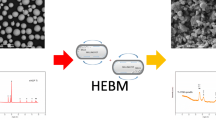Abstract
The phase composition and mechanical properties of ZrO2-based ceramics prepared by sintering plasmochemical powders of complex morphology in air and in vacuum were compared. Sintering at a high temperatures in vacuum produced material exhibiting high density and good mechanical properties, in which the zirconium dioxide was entirely in the tetragonal form.
Similar content being viewed by others
References
M. Kagava, M. Kikuchi, R. Ono, et al., “Synthesis of ultrafine tetragonal ZrO2 coprecipitated with Al2O3 by the spray-ICP technique,” J. Am. Ceram. Soc.,66 No. 11, 1081–1087 (1983).
N. I. Kabanova and V. A. Dubok, “Phase and chemical changes during the sintering of partially stabilized zirconium dioxide,” Poroshk. Metal., No. 5, 85–89 (1992).
K. M. Liang, G. Orange, and G. Fantozzi, “Evaluation by indentation of fracture toughness of ceramic materials,” J. Mater. Sci., No. 25, 207–214 (1990).
H. K. Schmid, “Quantitative analysis of polymorphic mixes of zirconia by x-ray diffraction,” J. Am. Ceram. Soc.,70 No. 5, 367–376 (1987).
F. F. Lange, “Transformation toughening. Part 3: Experimental observation in the ZrO2-Y2O3 system,” J. Mater. Sci.,17 No. 1, 240–246 (1982).
P. Ramaswamy and D. C. Agrawal, “Effect of sintering zirconia with calcia in very low partial pressure of oxygen,” J. Mater. Sci., No. 22, 1243–1248 (1987).
A. Krell and W. Pompe, “Grain boundary microdamage due to viscoelastic relaxation of residual stresses in alumina ceramics,” Phys. Status Sol. (A),111 No. 1, 109–117 (1989).
R. Ruh and H. J. Garrett, “Nonstoichiometry of ZrO2 and its relation to tetragonal—cubic inversion in ZrO2,” J. Am. Ceram. Soc.,50 No. 5, 257–261 (1967).
Additional information
Institute of the Physics of Strength and Materials Science, Siberian Branch, Russian Academy of Sciences. Translated from Poroshkovaya Metallurgiya, Nos. 1–2, pp. 26–30, January–February, 1994.
Rights and permissions
About this article
Cite this article
Savchenko, N.L., Sablina, T.Y., Poletika, T.M. et al. High temperature vacuum sintering of plasmochemical powders based on ZrO2 . Powder Metall Met Ceram 33, 25–28 (1995). https://doi.org/10.1007/BF00559702
Received:
Issue Date:
DOI: https://doi.org/10.1007/BF00559702




